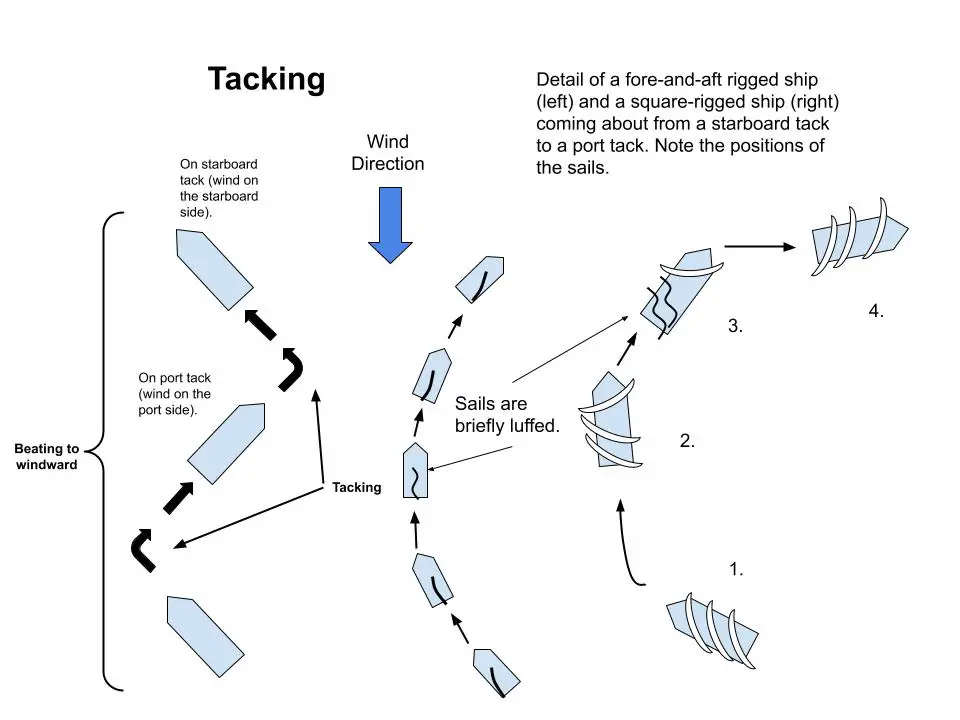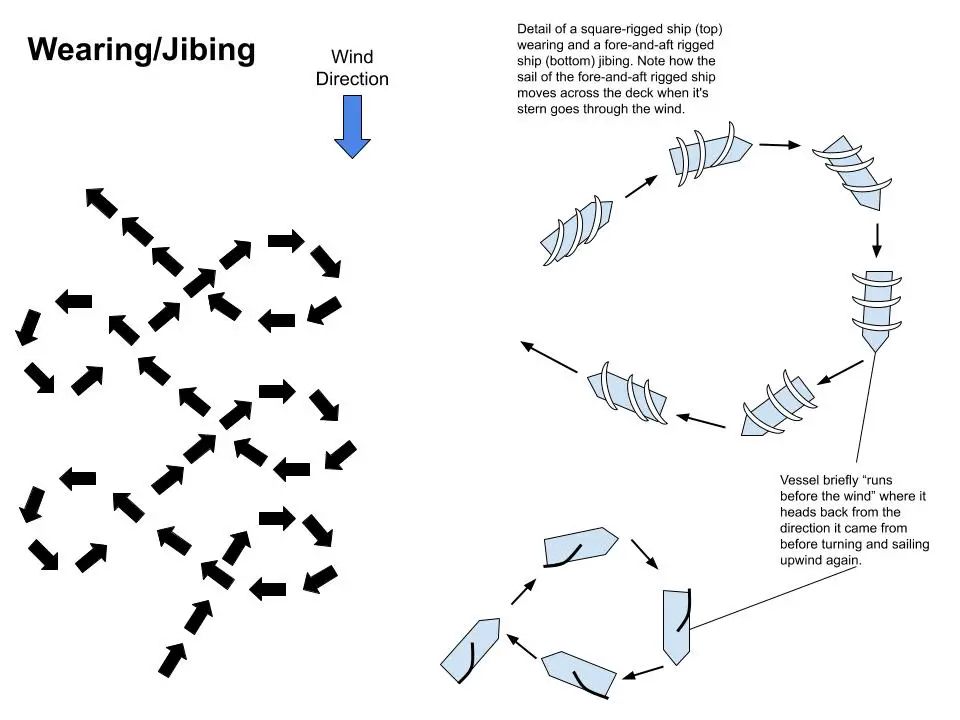The wind is essential to sailing. A sailboat will not move forward without wind, so every sailor knows that wind can become their best friend or their greatest enemy.
If the ancient ships had no wind, they could not move forward unless they rowed or got towed somehow. Wind for the ancient vessels was significant, or they would remain in what was known as becalmed or without wind.
Table of Contents
- The Becalmed State Of Ancient Ships
- About Wind And Ancient Sailing Ships
- Tacking, Jibing Sailing Maneuvers, And The Wind
- 12 Reasons Why Understanding the Wind is Vital for Every Sailor
- Frequently Asked Questions
- Related Questions
The Becalmed State Of Ancient Ships
The ancient sailors could not sail without wind; they had to row or be towed. Not being able to sail because there was no wind was so familiar, so there is even a term for it that is known as becalmed.
In the Collins Dictionary, the word becalmed is defined as:
(Of sailing boat or ship) motionless through lack of wind.
Collins Dictionary
These ancient sailors understood that when they were in a becalmed state, all they could do was try to wait for the wind to come so that they could continue to sail.
The becalmed state of a ship could happen for a few hours, a few days, and even weeks at a time. Getting out of the “becalmed” depended on the wind to come for the ship to move forward.
About Wind And Ancient Sailing Ships
Sailing and ancient ship dates back literally thousands of years. For thousands of years, men have been using the wind to be able to glide over the waters to get to their destination.
The Austronesian people, including present-day Taiwan, Indonesia, Vietnam, and Cambodia, were said to be the first to invent a sailing vessel that could sail over large bodies of water.
Ancient Egypt in the Mediterranean also used sailing ships for the rivers and coastal waters. Sailing and using the wind to propel people over the water has long been something that has been around for centuries.

Listen To Our Podcast About Ancient Ships, Wind, Sun, Stars, And Innovation below or by clicking here.
What has changed over the years is the technology and the understanding of how to use the wind and sails better to propel the sailors and their ships in the direction they need to go.
Ancient boats, particularly sailing boats, are something people have had for 1000s of years. Throughout all these years, the sailors depended upon the wind to move them in the right direction and to their destination.
Sailing and how human beings have been able to use the wind for thousands of years shows us the human spirit of ingenuity. Some of the first boats for sailing were made from reed, wood, and even stretched animal skin.
These materials would break down quickly and easily, so they did not have long-lasting effects or records. Because none of these boats are left, it can be challenging for archaeologists and historians to pinpoint precisely when and how the sailing vessel started.
For a long time, the sailboats also had rowers that would allow the boat to continue moving if the wind changed direction or they could no longer sail. As technology improved, so did the ability of these sailors.
Tacking, Jibing Sailing Maneuvers, And The Wind
Some of the greatest inventions in transportation by sail and ship were the tacking, jibing, and beating in sailing maneuvers. The creation and understanding of these maneuvers opened up a whole new way for the ancient sailships to move across the world’s waters.

Tacking was the sailing maneuver in which the vessel’s desired course is in the wind. The ship or the boat’s bow is turned through to the wind so that the direction the wind blows changes from one side of the boat to the other. The tacking maneuver allows the boat to progress in the wind, even if it is going straight at them and not behind them.
Tacking is essential because a sailing ship cannot proceed directly into the wind but often needs to make the tacking movement continue to move forward.

The opposite maneuver from tacking is known as jibbing. Wearing or jibbing is a sailing maneuver when the vessel reaches a downwind and then turns its stern to the wind. In a jib, the mainsail will cross the boat’s center while the jib is pulled to the other side of the ship.
These maneuvers were critical in sailing because they allowed the sailors to sail in all kinds and directions of the wind and stay on their desired course. Without them, it is hard to keep on the course, and you must go wherever the wind takes you with your sails.
Beating is also a maneuver used in sailing; I have used it when the wind is low. Beating is a point of sail. When the wind is upwind, you sail the boat in a zigzag pattern to reach your destination through a zigzag but almost straight line.
The inventions of these basic sailing maneuvers allowed these ancient ships to move through all kinds of wind. They were in a “becalmed” state if there was no wind and would have to wait for the wind to continue moving forward.
12 Reasons Why Understanding the Wind is Vital for Every Sailor
As someone who frequently sails, especially on the unpredictable waters of Lake Michigan, I can’t emphasize enough the significance of the wind in sailing. Over the years, one of the essential skills I’ve honed is the ability to read the wind. It’s both an art and a science.
Here are 12 reasons why the wind is crucial in sailing and why every sailor must understand it:
- Primary Propulsion: At its core, sailing is about harnessing the power of the wind. Without it, a sailboat is left adrift. Understanding the wind means knowing how to utilize nature’s energy to move the boat forward.
- Directional Control: Learning to read the wind meant mastering the ability to steer the boat. The direction from which the wind blows plays a vital role in determining the boat’s course.
- Speed Regulation: The strength or speed of the wind directly influences a boat’s speed. A good sailor understands how to adjust the sails to optimize or control the boat’s velocity based on wind strength.
- Safety: Gusts, squalls, or rapid wind direction changes can pose safety challenges. Recognizing these wind patterns is essential to prevent accidents and ensure the safety of everyone on board.
- Tacking and Jibing: These fundamental sailing maneuvers rely on wind understanding. Knowing when and how to tack or jibe, especially on waters like Lake Michigan, can make the difference between a smooth sail and a challenging one.
- Optimal Performance: For competitive sailors or those who seek to push their boat’s limits, understanding wind gradients, shifts, and gusts can provide the edge needed for optimal performance.
- Sail Setting: Different wind conditions require different sail settings. Recognizing the nature of the wind helps adjust the sails appropriately, whether reefing in strong winds or maximizing sail area in light breezes.
- Avoiding Weather Hazards: Changes in wind patterns can often signal approaching weather disturbances. A sailor who understands the wind can anticipate these changes and act accordingly.
- Enhanced Endurance: In long-distance or endurance sailing, understanding and utilizing prevailing winds and currents can save time and energy, ensuring a more efficient journey.
- Energy Conservation: Modern sailboats often come equipped with engines. However, relying primarily on the wind for propulsion conserves fuel and is environmentally friendly.
- Building Intuition: Reading the Wind has also been about developing an intuitive connection with nature. Over time, understanding the wind’s nuances helps predict its behavior, leading to a more harmonious sailing experience.
- Increased Confidence: A sailor confident in their ability to read and adapt to the wind is more likely to take on challenging routes or conditions, enriching their overall sailing experience.
The wind is not just a force; it’s the very essence of sailing. Its understanding is the key to unlocking a world of possibilities on the water. While the winds of Lake Michigan have taught me many lessons, the most valuable has been this: to sail is to dance with the wind and to do so, one must first understand its rhythm and whims.
At A Bus On A Dusty Road, we talk about everything about travel, life, sailing, and ex-pat living. We are all about “Living Life As A Global Citizen.” We explore social, cultural, and economic issues and travel.
We would love to have you be part of our community. Sign up for our newsletter to keep up-to-date by clicking here. If you have any questions, you can contact me, Anita, by clicking here.
Listen to our Podcast called Dusty Roads. You can find it on all major podcast platforms. Try out listening to one of our podcasts by clicking here.
Subscribe to our A Bus On A Dusty Road YouTube Channel filled with great videos and information by clicking here.
Frequently Asked Questions
What did ancient sailors do when there was no wind to power their ships?
When there was no wind, ancient sailors relied on alternative methods of propulsion such as rowing or being towed by other ships or smaller boats.
Were ancient ships completely dependent on wind for movement?
While wind was crucial for sailing, ancient ships were equipped with oars, allowing them to row when wind conditions were unfavorable or nonexistent.
How did sailors navigate during periods of no wind?
Navigation during calm periods was challenging. Sailors often used stars, landmarks, and celestial navigation to guide their ships when wind was not available.
What was the term used for a ship that was stuck without wind in ancient times?
A ship without wind was said to be “becalmed.” This term described the situation when a ship was trapped in an area of the sea with no wind to fill its sails.
Did ancient sailors have any techniques to harness even the slightest breeze?
Yes, sailors would use any available breeze by adjusting the sails and employing skilled techniques to catch and utilize even the faintest wind currents.
Were there specific regions where ships were more likely to be becalmed in ancient times?
Certain areas, such as the doldrums near the equator, were notorious for having little to no wind. Sailors often tried to navigate these regions quickly or choose alternative routes.
How did ancient sailors cope with the challenges of becalmed seas on long voyages?
Sailors had to be resourceful. They carried extra provisions and water to endure longer journeys during calm periods and were prepared for the physical demands of rowing.
Were there any inventions or technologies to assist ships in the absence of wind in ancient times?
While there were no engines like those in modern ships, some ancient vessels had rudimentary mechanical devices, such as capstans, to assist with rowing and other maneuvers.
Did ancient sailors develop specific strategies to escape becalmed areas?
Sailors would strategically plan their routes, avoiding known becalmed zones when possible. They also relied on the expertise of experienced navigators to find favorable winds.
Were there any myths or superstitions associated with being becalmed in ancient maritime cultures?
Yes, being becalmed was often considered a bad omen or a sign of displeasure from the gods. Sailors sometimes engaged in rituals or superstitions to invoke favorable winds.
Related Questions
How Much Wind Is Too Much For A Beginner Sailor?
For a beginner sailor, the wind is usually recommended to be under 10 knots. Those who are more experienced or with a larger boat can consider going up to 12 knots of wind. A knot is not the same as miles per hour or kilometers per hour but is faster than these measurements.
By clicking here, you can discover How Much Wind Is Too Much For A Beginner Sailor?
No Experience Sailing, 6 Tips To Get Started
If you are going to take up sailing, you first must get on a boat and find out if sailing is suitable. The best sailors can handle their boats in all kinds and types of weather. Find a class that you can join and get certified. Sailing requires knowledge and skill. Find yourself a sailing community that you can be part of.
By clicking here, you can discover No Experience Sailing, 6 Tips To Get Started.


